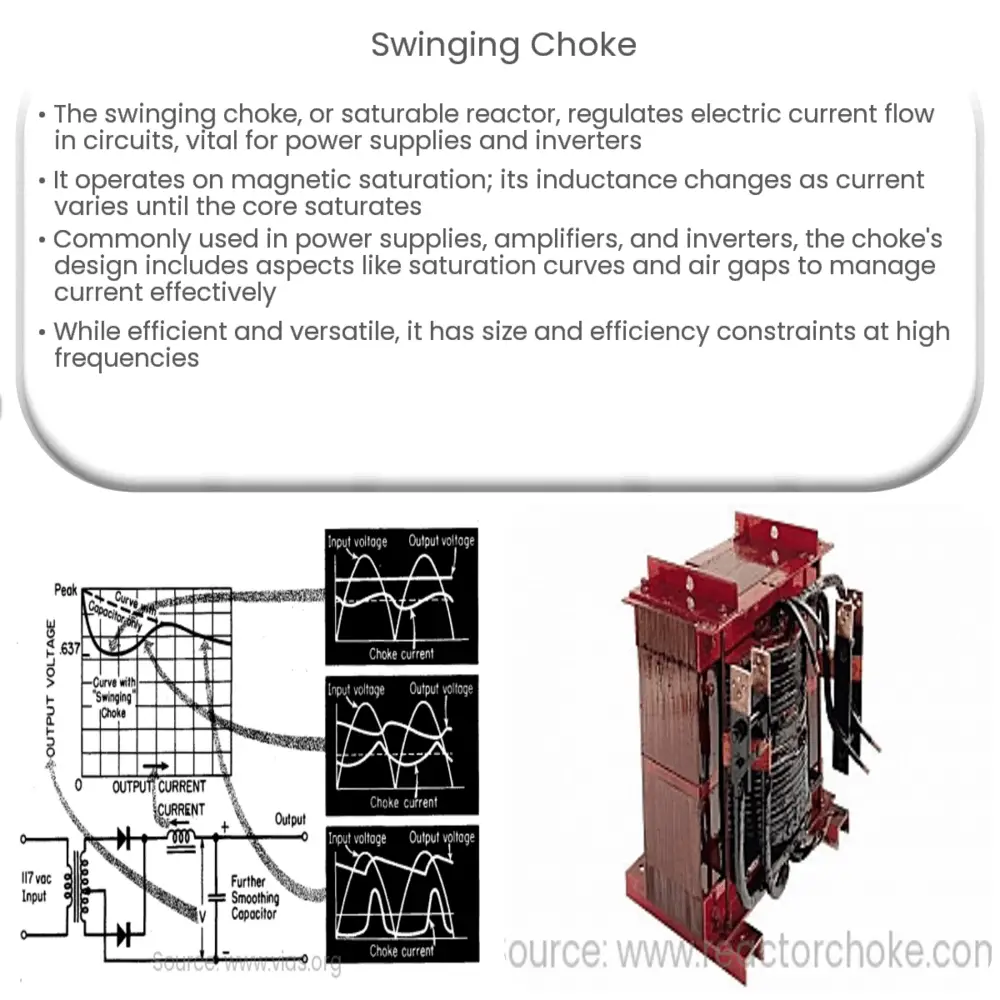Explore the swinging choke’s working principle, applications, technical aspects, and limitations in electronics and electrical engineering.

Understanding the Swinging Choke
The swinging choke, also known as a saturable reactor or magnetic amplifier, is an essential component in many electrical and electronic systems. It’s primarily used to regulate the flow of electric current in a circuit, which is crucial in various applications like power supplies and inverters. Its uniqueness lies in its ability to adjust its inductance based on the current flowing through it.
Working Principle of the Swinging Choke
The swinging choke operates on the principle of magnetic saturation. A core made of ferromagnetic material, which can be easily magnetized and demagnetized, forms the central part of the choke. When an electric current passes through the coil wound around this core, a magnetic field is generated.
The strength of this magnetic field is directly proportional to the current passing through the coil until the core becomes fully saturated. Once the core reaches its saturation point, any additional increase in current will not lead to a significant increase in the magnetic field strength. This phenomenon results in a change in the choke’s inductance, allowing it to limit the amount of current passing through the circuit.
Applications of the Swinging Choke
The swinging choke finds numerous applications in the field of electronics and electrical engineering. Some of its most common uses include:
The ability of the swinging choke to adapt its inductance based on the current flowing through it makes it a versatile tool in managing electrical power in various settings. It’s efficient, reliable, and a vital part of many electrical systems. However, it’s also important to understand its limitations and the technical aspects that underlie its functionality.
Technical Aspects of the Swinging Choke
The design and operation of a swinging choke involve several technical aspects. Understanding these can help us appreciate the complexity and usefulness of this device. A key factor is the choke’s saturation curve…
…which is a graphical representation of the relationship between the magnetic flux density and the magnetizing force. The curve typically has two distinct regions: the initial linear region, where the flux density increases proportionally with the magnetizing force, and the saturation region, where the flux density levels off despite an increase in the magnetizing force.
The point at which the core material transitions from the linear region to the saturation region is known as the knee point. The design and materials of the swinging choke are chosen to ensure that this knee point occurs at the desired level of current. This allows the choke to effectively control the current within the specified range.
Another crucial aspect of the swinging choke’s design is the air gap in the magnetic path. The air gap is included to prevent the core from reaching saturation too quickly. It effectively increases the amount of magnetic field strength required to fully saturate the core. Thus, the inclusion of an air gap allows the swinging choke to handle a broader range of currents.
Limitations and Considerations
While the swinging choke is an effective and versatile device, it does have some limitations. For instance, it can be relatively large and heavy, which can pose challenges in certain applications. Also, its efficiency can decrease at high frequencies due to the skin effect and proximity effect. Therefore, it is essential to consider these factors when choosing a swinging choke for a particular application.
Conclusion
In conclusion, the swinging choke is a valuable tool in the field of electronics and electrical engineering. Its ability to adjust its inductance based on the current flowing through it makes it a versatile and efficient solution for managing electrical power. However, understanding its working principle, applications, technical aspects, and limitations is crucial for making the most of this device. While it is not without its challenges, the swinging choke’s benefits in enhancing the performance and reliability of electronic systems cannot be overstated.

